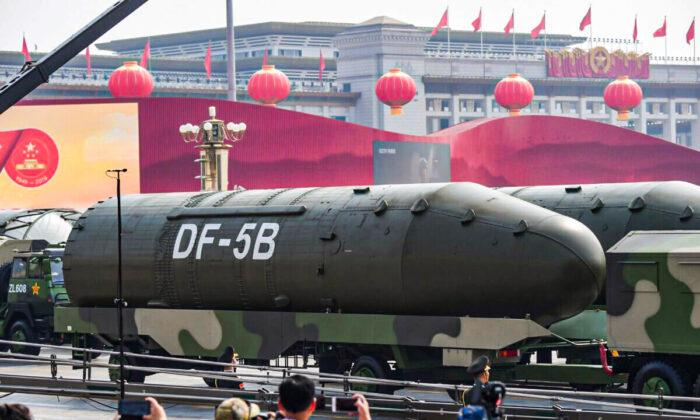China likely has more nuclear warheads equipped to its long-range missiles than the United States, as indicated by the disclosure of a classified briefing made to Congress by the Pentagon’s top nuclear commander.
That law requires U.S. Strategic Command to inform Congress if and when China surpasses the United States in the number of its active intercontinental ballistic missiles (ICBMs), the number of its ICBM launchers, or the number of nuclear warheads equipped to its ICBMs.
The Mystery of China’s Warheads
Though Richard’s classified notification to Congress could mean that the Chinese communist regime has numerically surpassed the United States in any of the three aforementioned areas, recent reports make two of these scenarios unlikely.Thus, given the unlikeliness that China created 100 new ICBMs or launchers within the month since the Pentagon published its report, Richard’s notification likely means that the regime has equipped its ICBMs with additional nuclear warheads, surpassing the 400 warheads the United States’ ICBMs are equipped with.
This is possible because many of China’s ICBMs utilize multiple independently targetable reentry vehicles (MIRVs), meaning each missile is equipped with multiple nuclear warheads, all of which can strike different targets.

In contrast to the United States’ Minuteman missiles, most of China’s ICBMs are capable of equipping three to five MIRVs, according to the Pentagon’s report, and the regime is building hundreds more silos capable of storing its newest DF-41 missile.
“Due to increases in China’s arsenal of ICBM missiles, launchers assigned to its ICBM brigades, and MIRV technology, the number of warheads that can be mounted on ICBMs threatening the United States is expanding,” the report said.
There has not yet been a clarification on the reasoning for Richard’s notification. Such may be published in the near future, however, as Inhofe and his colleagues said in their letter that Richard’s notification failed to meet the requirements of Section 1648, which states that the notification must include an unclassified paragraph detailing the reason for the notification.
“While we appreciate your timely submission of the classified Section 1648 notification, the statute explicitly requires an unclassified determination, which was not provided,” the letter said.
“We therefore do not consider the requirement under PL 117-81 to be satisfied and encourage both you and your successor to work with relevant departments and agencies to fulfill the requirement.”
Likewise, Fischer said that the release of an unclassified summary was necessary to ensure that Americans fully understood the threat posed by China’s communist regime.
The Growing Nuclear Threat
The Chinese Communist Party (CCP), which rules China as a single-party state, has invested heavily in expanding and modernizing its nuclear arsenal in recent years. The Pentagon estimates that the CCP will have at least 1,000 nuclear weapons by 2030 and 1,500 by 2035.According to the USCC’s 2021 report, the CCP is also doubling the number of its ICBM launchers in some units, and it is believed that as many as half of the regime’s 40 missile brigades are nuclear-capable.
A spokesperson for U.S. Strategic Command said in an email that an unclassified message had now been sent to Inhofe and the other lawmakers.
“We are currently working with the intelligence community to determine what, if any, of the classified memo can be unclassified and provided,” the spokesperson said.





